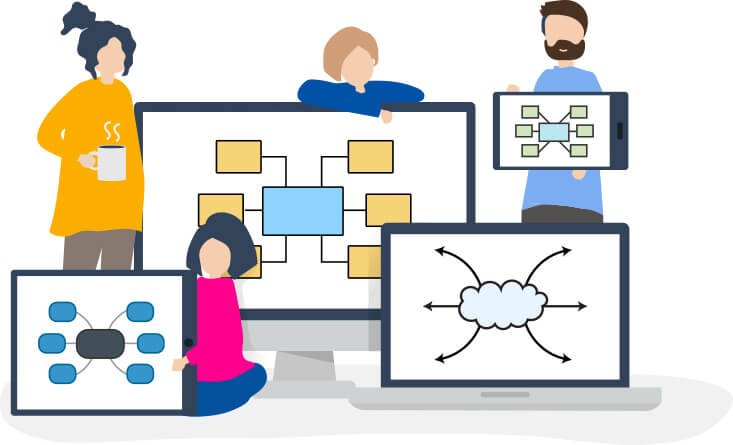Mind Mapping is one of the most useful learning tools ever created. So, what makes it so special? What are the five essential characteristics of Mind Mapping?
1. Mind Mapping is a way to visually organize information
Mind Mapping is an effective way to represent information gathered through research or observation in a graphical format that highlights associations between ideas and content, integrates concepts with their subparts, identifies interdependent relationships between topics, details cause-and-effect relationships, shows alternate paths to reaching a solution or goal, and more.
2. The positioning of words within the Map indicates the relations between them
The relative position of words on a Mind Map conveys meaning about how those ideas relate to one another. For example: if two items are positioned close to one another the user will understand that there is a strong connection between those pieces of information. If two items are positioned far from one another on a Mind Map, then the user will know that there is a weak association between them.
3. Mind Maps can be created quickly and easily
The average person can complete a simple mind map in less than five minutes! There’s no need to write neatly or worry about spelling, grammar or punctuation. In fact, creating messy but colorful Mind Maps might help you to think more creatively and produce better results because you have not been inhibited by typing conventions or your inner editor!
4. A core concept at the center acts as a hub for other parts of the map
The central key word serves to focus the map, making it easier to scan quickly for information about that key concept. This central word is usually presented in a larger or bolder typeface to stand out—in fact, this core word should really stand out!
5. Connection between branches are achieved through association and elaboration
When you link two related ideas with a connecting line , users will understand the relationship between them. If there are multiple connections between items, then users will understand that those items share close relationships with one another. This shows how individual pieces of knowledge are interconnected which helps the user see the whole bigger picture.
The Five Essential Characteristics of Mind Mapping help people remember learning material better by creating clearly defined paths for recalling information gathered from research or observations. Mind Maps help learners identify cause-and-effect relationships, alternate paths to reaching a solution or goal, and interdependent relationships between topics; to make connections between associated ideas; to understand the bigger picture by organizing information around central concepts (the hub of the map); and to simplify material through visualization.
Creating colorful mind maps will improve your ability to think creatively and produce better results because you will not be inhibited by typing conventions or your inner editor!
Some other essential characteristics of Mind Mapping are:
1. Mind Mapping is an effective way to represent information gathered through research or observation in a graphical format.
2. Mind Maps help learners identify cause-and-effect relationships, alternate paths to reaching a solution or goal, and interdependent relationships between topics; to make connections between associated ideas;
3. Creating colorful mind maps will improve your ability to think creatively and produce better results because you will not be inhibited by typing conventions or your inner editor!
4. Mind Map claims that visual organization of ideas improves the user’s ability to understand complex material.
5. A core concept at the center acts as a hub for other parts of the map… …
6. A central key word serves to focus the map making it easier to scan quickly for information about that key concept.
7. You can achieve better results by organizing information around central concepts (the hub of the map) .
8. Mind Mapping will help you simplify material through visualization and it will improve your ability to think creatively and produce great results!
9. Mind Mapping is a way to organize information from different sources in a simple graphical format.
10. Good Mind Maps have a hierarchical structure with a clear emphasis on the core concept or key word at the center of the map. This helps you create better connections between related concepts and ideas .
11. Wherever you see nodes, you can expect there to be branches leading off them – this is because every node has one parent node which it branches from, and one or more child nodes branching from it. In turn each child node will have its own children too!
12. The mind mapping technique uses coding symbols to branch out from central keywords which form the Mind Map. These codes are linked to their respective branches which helps you create better connections between related ideas and concepts.
13. In a good Mind Map, there is a hierarchical structure with a clear emphasis on the core concept or key word at its center which makes it easier for you to scan quickly for information about that key concept.
14. There are different elements which can be found inside a Mind Map such as: images, drawings, colored lines/circles connecting nodes, numbers next to nodes, icons or symbols attached to some branches, shapes of maps etc.
15. Mind Mapping claims that visual organization of ideas improves the user’s ability to understand complex material by helping learners identify cause-and-effect relationships, alternate paths to reaching a solution or goal, and interdependent relationships between topics; make connections between associated ideas;
16. Create colorful mind maps which will improve your ability to think creatively and produce better results because you will not be inhibited by typing conventions or your inner editor.
